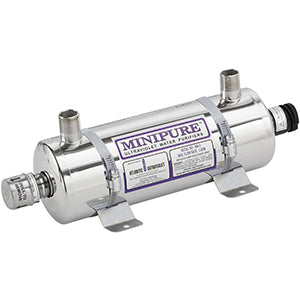Germicidal / UV-C Lighting
Germicidal or Ultraviolet Germicidal Irradiation (UVGI) lamps are used to disinfect air and water, cure inks and coatings and disinfect foods. If you don't see what you are looking for, call 800.784.1998 to speak with one of our lighting specialists.
Warning: UVGI radiation is extremely harmful to skin and eyes.
About UV-C Germicidal Lighting
Ultraviolet germicidal lighting has been used for decades in air, surface, and water purification applications. UVC fixtures and bulbs can be found most often in medical and research settings, where they are used to deactivate viruses, bacteria, mold, and fungi.
Since the global COVID-19 coronavirus outbreak, UV-C lighting has become one of the chief weapons in fighting both COVID-19 and other pathogens. Fixtures using germicidal light can now be found in schools, restaurants, medical clinics, dental offices, and residential homes.
Air & Surface Disinfection Fixtures
Disinfecting air and surfaces in buildings has grown exponentially in popularity as administrators, business owners, and private citizens have grown aware of how UV-C light can kill germs.
UV-C fixtures can be used to kill harmful microbes as they circulate through air in rooms, in ventilation ducts, and settle on surfaces throughout a building. UV manufacturers have created numerous types of air and surface disinfection systems to meet the demand of any industry and application.
Prices for air and surface ultraviolet germicidal fixtures can range from under to $200 to over $50,000, depending on the number of UV bulbs, germicidal output power, and time/space the fixture can treat.
Water Purification Fixtures
For decades, ultraviolet water purification has been used by municipalities and industry to deactivate pathogens in water supplies and liquid containers.
UV-C water purifiers can be installed at the point of use or the point of origin of water flow. They can handle a few gallons per minute to hundreds, depending on the size of the purifier.
Liquid storage tanks can become a breeding ground for harmful microbes, so manufacturers have designed tank immersion and headspace UV units to combat this risk. These types of UV-C water disinfection fixtures can also be used for well water applications.
UV-C Light Bulbs
UV-C bulbs come in a wide range of brands, bases, lamp shapes, wattages, lengths, and features, and we carry over 1,300 different germicidal bulbs. And even with that many, we're still missing many very specialized UV-C lamps that were built for particular manufacturers and systems.
Many germicidal light bulbs have been designed with common bases (2G11, G5, G13) and finding compatible ballasts and sockets is quite easy. Other times, it can be difficult matching bulbs, ballasts, and sockets, especially as the system grows in complexity and output.
UV Ballasts
While many ballast manufacturers have a series of specialty UV-C germicidal ballasts, some regular fluorescent ballasts can also run germicidal bulbs.
Again, as the germicidal bulb becomes more specialized, the less similar it is to a fluorescent lamp and the more difficult it can be to find a compatible ballast.
We've tried to make it easier to find compatible bulb-ballast combinations for UV bulbs, and we are always expanding our ballast cross references and sources.
Measuring UV-C Light
Measuring UV-C light output from fixtures and individual lamps can be difficult. While manufacturers sometimes publish the UV wattage output of their bulbs, that may not be helpful to the average end user.
In addition, complicated formulas have been found that describe the UV output and dosage at certain distances over time, but that level of calculation may be overkill for many people.
Two easy ways to measure UV-C output are dosimeter cards and a UV-C light meter. The dosimeter cards change colors as UV-C light is applied to them, showing when certain thresholds have been crossed in terms of UV dosage. And UV-C light meters show the exact µW/cm2 of a bulb at a certain distance. These can make it much easier to measure germicidal light from a system.








